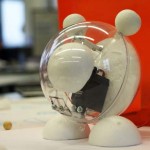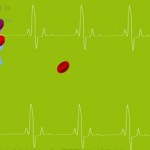By using a PPG system (photoplethysmograph), data from the heart beat can easily be obtained. Although the device is relatively simple, the design opportunities that are created are fast and as complex as the designer’s wishes. In the module “sense your heart”, master students created several very interesting ideas and prototypes. The goal of this module was to get a good understanding of the workings of the human heart and how this working can be monitored. Secondly a learning objective was to implement these measurements in a concept using a self-built Photoplethysmography sensor and corresponding software. This technology can be used for measuring the heart rate, which in our case was used to determine the heart-rate variability which can be an indicator for relaxation or arousal.
Concept 1: Connecting people

Our concept makes use of the calculated heart rate variability to make an estimation of the arousal level of two related people. By making use of a robotic actuator and an internet connection two people can become aware of each other’s arousal state, creating an incentive for a conversation. When person A is really relaxed or aroused in some way, this behaviour will be detected by the algorithm which will send this status to person B’s laptop. At his location the robot (representing person A) will move according to the state of arousal, thus giving person B a subtle indication of how person A is feeling. [PDF Report, 1.3M]
Concept 2: Book reading

Reading, as an activity, could also influence the heart rate. The heart rate could decrease when one is focused and reading a relaxing book. Interesting would be if this information on how the person is experiencing the book, according to his or her heart rate, is used as ambient feedback to the user and his environment. We designed an application that can be used while reading, it gives ambient feedback on how the person is experiencing the book, according to his/her heartbeat, to the reader and the environment. [PDF Report, 800K]
Concept 3: Gaming

The game starts with the user being hooked up to the PPG. Data about the player’s heart is subtracted, from which the heart rate is calculated. Elevating the heart rate would make an image of the heart go up, and lowering the heart rate makes this same image move downwards. The meaning of the game is to move the heart up and down and collect as many red blood cells as possible. Because the red blood cells move towards the heart, the player has to try to move the heart up and down in order to score points. When a player has gathered XXX points, the red blood cells start moving faster what would indicate the next level. The faster moving cells are harder to hit, and should have an impact on the player’s heart rate. This then creates another difficulty aspect to the game. keeping in control of your heart rate and breathing is essential to be able to score well in the game. When a second players joins the game, they can compete for the red blood cells. Both their scores will be counted. When one player gathers more points then the other, and get to the next level, it becomes even harder for the lesser player to overtake the winner. This friction will create a dynamic situation that in it’s turn would make it even harder for both players to regulate their heart rate. If a players fails to receive a significant number of cells, this player will loose the game. Loosing is caused by the counter that also registers missed blood cells, that will be subtracted from the players total points. [PDF Report, 400K]